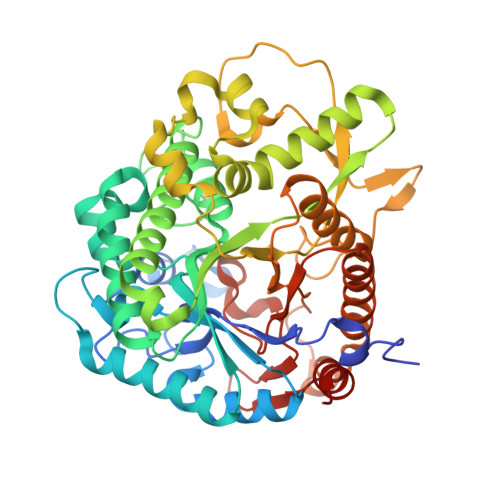Effects of active site cleft residues on oligosaccharide binding, hydrolysis, and glycosynthase activities of rice BGlu1 and its mutants
Pengthaisong, S., Ketudat Cairns, J.R.(2014) Protein Sci 23: 1738-1752
- PubMed: 25252199
- DOI: https://doi.org/10.1002/pro.2556
- Primary Citation of Related Structures:
4QLJ, 4QLK, 4QLL - PubMed Abstract:
Rice BGlu1 (Os3BGlu7) is a glycoside hydrolase family 1 β-glucosidase that hydrolyzes cellooligosaccharides with increasing efficiency as the degree of polymerization (DP) increases from 2 to 6, indicating six subsites for glucosyl residue binding. Five subsites have been identified in X-ray crystal structures of cellooligosaccharide complexes with its E176Q acid-base and E386G nucleophile mutants. X-ray crystal structures indicate that cellotetraose binds in a similar mode in BGlu1 E176Q and E386G, but in a different mode in the BGlu1 E386G/Y341A variant, in which glucosyl residue 4 (Glc4) interacts with Q187 instead of the eliminated phenolic group of Y341. Here, we found that the Q187A mutation has little effect on BGlu1 cellooligosaccharide hydrolysis activity or oligosaccharide binding in BGlu1 E176Q, and only slight effects on BGlu1 E386G glycosynthase activity. X-ray crystal structures showed that cellotetraose binds in a different position in BGlu1 E176Q/Y341A, in which it interacts directly with R178 and W337, and the Q187A mutation had little effect on cellotetraose binding. Mutations of R178 and W337 to A had significant and nonadditive effects on oligosaccharide hydrolysis by BGlu1, pNPGlc cleavage and cellooligosaccharide inhibition of BGlu1 E176Q and BGlu1 E386G glycosynthase activity. Hydrolysis activity was partially rescued by Y341 for longer substrates, suggesting stacking of Glc4 on Y341 stabilizes binding of cellooligosaccharides in the optimal position for hydrolysis. This analysis indicates that complex interactions between active site cleft residues modulate substrate binding and hydrolysis.
Organizational Affiliation:
School of Biochemistry, Institute of Science, and Center for Biomolecular Structure, Function and Application, Suranaree University of Technology, Nakhon Ratchasima, 30000, Thailand.



















